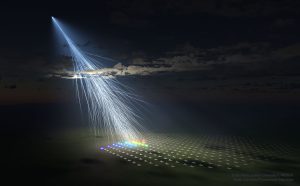Some cosmic rays have an almost unbelievable energy. The source of such high energy particles is still a mystery Suggested explanations include young neutron stars and active galactic cores.
Ultra high energy cosmic rays have an energy greater than 1 Exa electron volts (1 EeV), ie. 1018 eV or 0.16 Joules.
The “Oh-My-God” cosmic ray particle detected in 1991 Fly’s Eye experiment had an energy of (320 +/- 90) Exa Electron Volts (EeV), that is 51 Joules. Assuming it was a proton, this means it was traveling at 0.9999999999999999999999951 times the speed of light. [Wikipedia].
A 58 g tennis ball with kinetic energy of 51 joules would be a travelling at 42 metres per second or 150 km/h. The average speed of a first serve by a professional tennis player is around the 190-200 km (https://tenniscreative.com/fastest-tennis-serve/).

A cosmic ray impacting the atmosphere a shower of secondary particles which are very extensive for high energy cosmic rays. Ultra high energy cosmic rays are detected by observing the fluorescence emissions from nitrogen molecules in air and the shower extends to the ground where particles can also be detected. Due to sun, moon and weather, fluorescence telescopes are usually limited to an about ten percent duty cycle.
The Pierre Auger Observatory covering 3000 km2 in Argentina detected 100 particles energies in the range 78–166 EeV in 16 years operation between 2004 and 2020. Operations of the fluorescence detectors are restricted to clear dark nights. https://iopscience.iop.org/article/10.3847/1538-4365/aca537#artAbst
The Telescope Array observatory in Utah detected a 240 EeV event in 2021. The Telescope Array announced a Hotspot in the sky in 2014 based upon the first five years of data. The Hotspot was observed near Ursa Major in data with E > 57 EeV. In the first five years data 22 of 72 events were observed in the Hotspot. The Hotspot had less events in the next 7 years of data. https://iopscience.iop.org/article/10.1088/1742-6596/2429/1/012011/pdf

Energetic Particle Strikes the Earth https://apod.nasa.gov/apod/ap231205.html
The Amaterasu particle, named after the sun goddess in Japanese mythology, was an ultra-high-energy cosmic ray detected in 2021 and later identified in 2023,[1] using the Telescope Array Project observatory in Utah, United States. It had an energy exceeding 240 exa-electronvolts (EeV) and was inferred through two dozens particles it sent toward ground detectors. This single particle appears to have emerged from the Local Void, an empty area of space bordering the Milky Way galaxy. The single subatomic particle held energy roughly equivalent to a brick dropping to the ground from waist height. https://en.wikipedia.org/wiki/Amaterasu_particle [accessed 6 Dec 2023]
